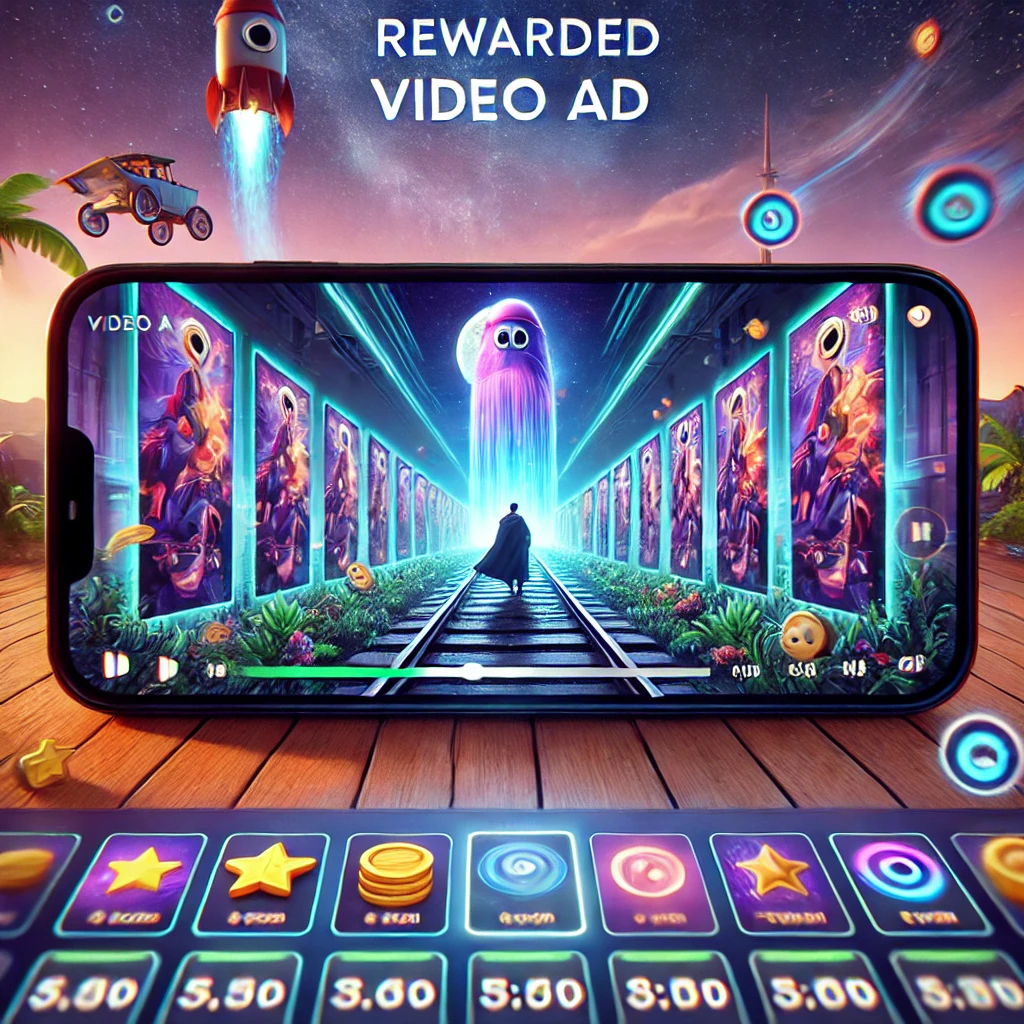The Evolution of Rewarded Video Ads: 2016 to Present
Since 2016, rewarded video ads have undergone a remarkable transformation, becoming one of the most effective and user-friendly advertising formats in the monetization ecosystem. Its growth has been driven by creative advancements, evolving user preferences, and technological innovations. This post will explore key trends in rewarded video ads from 2016 onwards, highlighting the changes in creative strategies that have helped them maintain relevance and appeal.
-
Contents
- 1 Interactive and Immersive Formats
- 2 Personalization and Targeting
- 3 Integration with Emerging Technologies
- 4 Contextual Relevance
- 5 Seasonal and Event-Based Creatives
- 6 Diverse Reward Structures
- 7 Cross-Promotion and Brand Collaborations
- 8 Optimization for Short Attention Spans
- 9 Data-Driven Creative Optimization
- 10 Focus on User Experience
- 11 Rewarded Video Ad from AppLixir
Interactive and Immersive Formats
Rewarded video ads have evolved from passive viewing experiences to more interactive and immersive formats. Initially, these ads were simple videos that users could watch to earn in-game rewards or app benefits. However, as user engagement became a top priority, advertisers began incorporating interactive elements into their ads.
By 2018, interactive features, such as mini-games or quizzes within the video, started gaining popularity. These elements transformed the ad experience, making it more engaging and allowing users to interact with the content rather than just watching it. Today, immersive experiences like Augmented Reality (AR) elements have become increasingly common, allowing users to engage with the ad on a deeper level. This shift has significantly improved user retention and engagement rates.
-
Personalization and Targeting
Continuing on The Evolution of Rewarded Video Ads: 2016 to Present Post, one of the most significant developments in the creative strategy of rewarded video ads is the increased focus on personalization and targeting. Thanks to advancements in data analytics and artificial intelligence, advertisers can now tailor ads to individual users based on their behavior, preferences, and demographic data.
For instance, an ad shown to a 25-year-old female gamer may differ from one shown to a 40-year-old male sports enthusiast. The goal is to make ads feel more relevant to users, which not only enhances engagement but also improves the likelihood of conversions. Personalization has been a game-changer in increasing the effectiveness of rewarded ads, ensuring that users find value in the content they engage with.
-
Integration with Emerging Technologies
The incorporation of emerging technologies has played a crucial role in the creative evolution of rewarded video ads. Augmented Reality (AR) is one such technology that has made waves in the advertising space since 2019. By adding AR elements to rewarded video ads, advertisers offer users a more immersive experience that allows them to interact with the ad in a more personal and engaging way.
Interactive elements, such as gamified ads, are another growing trend. These ads often feature mini-games or puzzles that users can complete during or after the video to unlock rewards. This interactive component not only extends the time users spend with the ad but also enhances their overall experience, making it feel less like an interruption and more like an integral part of their activity.
-
Contextual Relevance
Contextual relevance has become an essential strategy for rewarded video ads, especially in gaming apps. Users are more likely to engage with an ad that feels like a natural part of their in-app or in-game experience. Advertisers have taken this into account by designing ads that blend seamlessly with the app’s environment, ensuring that they don’t disrupt the user experience.
For example, a rewarded ad in a gaming app might offer rewards related to gameplay progression, such as in-game currency or items, enhancing the player’s experience instead of distracting from it. This trend towards contextual integration has helped reduce ad fatigue and has contributed to higher levels of user satisfaction.
-
Seasonal and Event-Based Creatives
Continuing on The Evolution of Rewarded Video Ads: 2016 to Present Post, since 2016, advertisers have increasingly focused on creating time-sensitive and event-based rewarded video ads. These creatives are designed to capitalize on seasonal events like holidays, sports tournaments, or cultural celebrations, making the ad content more relevant to the current context.
For instance, a gaming app could offer double rewards for watching a video ad during the holiday season, aligning the ad’s message with festive events or seasonal sales. Seasonal creatives have proven to be highly effective in driving engagement, with some apps reporting substantial increases in revenue during such periods. For example, Fiveamp’s PickCrafter game saw a 165% increase in profits by incorporating seasonal creatives into their rewarded video ads.
-
Diverse Reward Structures
Rewarded video ads have become more sophisticated with diverse reward structures designed to keep users engaged. Initially, users would watch a video ad and receive a standard reward, such as in-game currency or bonuses. However, modern rewarded ads now offer more dynamic and flexible reward systems.
Progressive rewards, where users receive increasing rewards for continued ad engagement, are a prime example of this. Another popular approach is choice-based rewards, which allow users to choose their preferred reward from several options. These strategies empower users, making them feel more in control of their experience and boosting overall engagement rates.
-
Cross-Promotion and Brand Collaborations
Continuing on The Evolution of Rewarded Video Ads: 2016 to Present Post, another emerging trend is the use of rewarded video ads for cross-promotion and brand collaborations. Many apps and games now use rewarded video ads to promote other apps or services, creating mutually beneficial partnerships. In-game collaborations with popular brands, for example, can enhance the user experience by offering exclusive rewards tied to a specific brand.
These types of ads can generate new revenue streams while simultaneously enhancing user experience with valuable or exclusive content. This cross-promotional strategy has allowed advertisers to expand their reach, create diverse content, and foster deeper engagement with their audience.
-
Optimization for Short Attention Spans
With user attention spans shrinking, rewarded video ads have become shorter and more impactful. Over the years, the average length of these ads has decreased, with most falling within the 15 to 30-second range. Advertisers focus on delivering concise messages while still ensuring that the ad provides value to the user.
Shorter ads are less intrusive, more digestible, and have a higher completion rate, which is crucial for rewarded video ads since users must watch the entire video to receive their reward.
-
Data-Driven Creative Optimization
The creative strategies behind rewarded video ads have become more data-driven in recent years. Advertisers regularly test different variations of ads, from visuals and messaging to rewards and formats, to determine what works best. This iterative approach allows for constant optimization, ensuring that the ads remain relevant and effective for different audience segments.
By leveraging real-time analytics, advertisers can track performance metrics such as engagement rates, ad completion rates, and conversion rates, and adjust their creative strategies accordingly. This data-driven approach ensures that rewarded video ads continue to evolve and improve over time.
-
Focus on User Experience
Above all, rewarded video ads have focused on creating a positive user experience. By optimizing the timing, placement, and content of ads, advertisers ensure that they complement, rather than disrupt, the user journey. Thoughtful ad placement, such as showing ads during natural breaks in gameplay, ensures that the user experience is smooth and uninterrupted.
Rewarded Video Ad from AppLixir
Last but not least on The Evolution of Rewarded Video Ads: 2016 to Present Post, since 2016, rewarded video ads have undergone significant creative evolution, driven by advances in technology, user behavior, and data analytics. Today, they are more interactive, personalized, and relevant than ever, making them one of the most effective ad formats for app and game monetization. As technology continues to evolve, we can expect rewarded video ads to become even more sophisticated, offering new ways to engage users while delivering value for advertisers.



